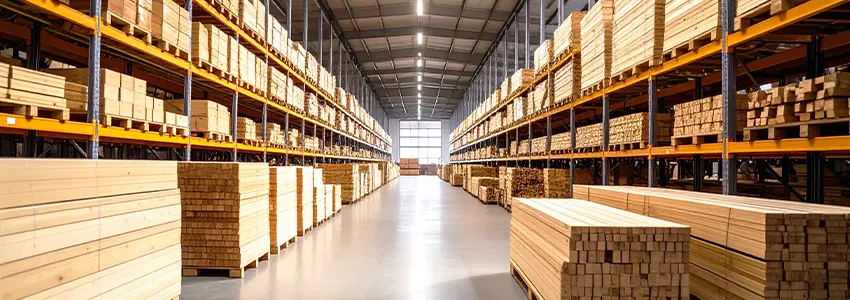
It’s hard to imagine that in the era of artificial intelligence, supercomputers, and automation, some businesses still heavily rely on manual work. Yet, that is true for many timber traders who still log and check timber without digital tools.
The lack of automation is only one of the problems in this sector. When we add pricing issues, new regulation demands, a decline in new building projects, and fewer requests for timber products, challenges pile up faster than freshly sawn logs.
The circumstances are tough, and many timber traders expect a slow year. But here’s a funny thing about challenges.
On one end, if you don’t resolve them, they grow bigger and add new problems. But on the other, they can serve as valuable, eye-opening lessons. Because when you stop to think and analyse the challenging situation, you gain critical insight that outlines the solution—or even a new business opportunity.
Analytics and problem-solving are kind of our thing here at acadon AG. That’s why our business approach involves strong customer support beyond IT services. We visit our customers on-site. We talk to them, discuss how we can improve, and listen to understand what bothers them.
During several customer conversations in the past months, a pattern emerged along with three distinctive challenges that most timber traders share.
Let’s explore each problem and how to overcome it.
When someone says January, what is the first thing you think about? Snow? Skiing? To me, January evokes childhood memories of counting timber logs.
My father ran a timber trade business, and our apartment was attached to the facility. I grew up just above a timber warehouse, and the first thing I’d see from the window was timber in our front yard.
So, each January, people walked outside our house and counted the logs. My mathematical brain loved it! I was five or six when I started to help my family business with timber inventory.
That’s how things were done many decades ago. However, some timber companies work in the same way to this day.
This traditional approach results in multiple issues affecting business flow, daily operations, and profits. The downsides of this method include:
Timber inventory is done only once a year, but monthly stock changes are not logged into the system. Traders typically don’t have insight into their actual monthly profit and loss statement (P&L), and the cost of goods sold (COGS) is not clear until the end of the year.
When a customer orders specific timber dimensions or types, sales reps must physically check availability on-site. Not only is that a waste of time and resources, but sales reps cannot share accurate and timely information with customers.
Subsequentially, timber traders can lose everything from money to credibility.
The industry is experiencing some of the biggest raw wood pricing fluctuations in years. The reasons can be found anywhere from supply chain roadblocks and raw material shortages to economic and geopolitical uncertainties across Europe, like the war in Ukraine.
Several stats speak about the market dynamics in 2023:
Timber traders must adapt their numbers to each price change, which adds complexity to their data. Namely, they already have ‘internal’ pricing changes after wood manipulations that often go unnoticed. I’ll use a sawmill example to explain:
> A sawmill business buys raw wood
> The facility dries and saws the material
> The wood shrinks its initial volume
> The entire wood parcel specifications change
Companies that cannot efficiently trace those changes—and that simultaneously need to adapt to the market dynamics—typically have many headaches.
Ultimately, without data transparency, they leave money on the table.
By the end of 2024, all timber trading companies residing in the EU must comply with the new European Union Deforestation Regulation (EUDR). It’s a tool for the EU to address the negative consequences of deforestation and forest degradation worldwide. Anyone selling or exporting wood in the EU will have to prove:
Timber traders typically don’t have systems to generate the required due diligence statements with wood data, geo-location, and production time. Without that information, larger traders cannot do risk assessment either.
So, what happens if companies don’t follow the rules after December 30, 2024, when the regulation entirely takes effect? They lose hundreds of thousands to millions of euros on fines.
The EUDR penalty is regulated individually at each country, and the EU direction is to apply measures like:
Is 2024 really going to be so gloomy for timber traders? What should you do, and where to start?
My two cents: start by reimagining the cornerstones of any healthy business—your systems and processes. Thankfully, today, we have access to technologies that can genuinely transform the operational side of the business in a short timeframe.
For timber traders, that’s a well-rounded and industry-tailored Enterprise Resource Planning (ERP) solution. It can respond to all three challenges successfully and provide the necessary solutions.
Challenge 1: Today, there are devices, scanners, barcodes, and ERP solutions available that digitalise and automate the inventory process, ensuring timber traders always have stock information at hand, and do more with less.
Challenge 2: Whichever process impacts your material price—market dynamics, wood manipulation process, or something else—a solid ERP system ensures you have all the financial data at your fingertips, fully transparent, and easily adjustable.
Challenge 3: An ERP ‘tailored to measure’ timber traders should have a built-in tracking system that can check the origin of the wood parcel. It helps timber traders with a due diligence system, ensuring the raw material is certified and can move forward throughout the supply chain.
Invest in your system. Not only to resolve current problems and ‘hit three birds with one stone’ but also to identify new opportunities that accelerate your business growth.
Reach out if you want to learn more about the acadon_timber app.
It’s an ERP designed to help timber businesses spend less time, money, and human resources and generate more data accuracy, compliance, and sales.





